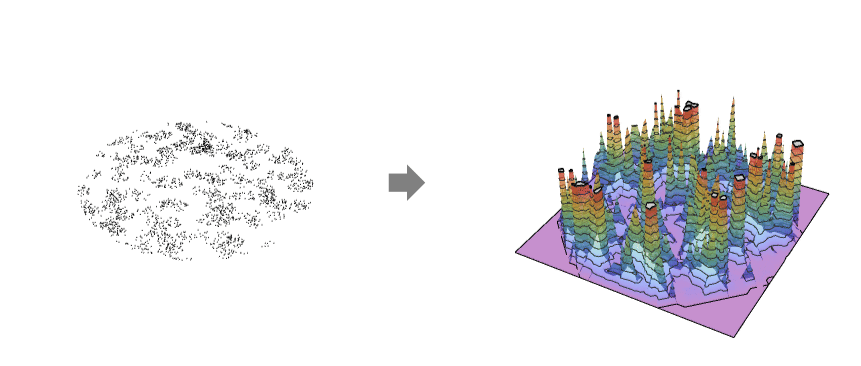PointDensity
PointDensity[pdata]
estimates the point density function ![]() from point data pdata.
from point data pdata.
PointDensity[pdata,pmethod]
estimates the point density function ![]() with the partition method pmethod.
with the partition method pmethod.
PointDensity[bdata,…]
estimates the point density function ![]() from binned data bdata.
from binned data bdata.
PointDensity[pproc,…]
computes the density function ![]() for point process pproc.
for point process pproc.
Details and Options



- Point density is also known as point intensity.
- The point density
 gives a function that describes how the number of points
gives a function that describes how the number of points  varies per length, area and volume in the observation region ℛ. The integral over the region is the total number of points
varies per length, area and volume in the observation region ℛ. The integral over the region is the total number of points  .
. - PointDensity gives a partition-based estimator that adapts to the point collection in how the partition is formed, effectively using a cell per point.
- The resulting point density function typically looks very noisy. To get a smoothed version of the point density, use HistogramPointDensity or SmoothPointDensity.
- Point density is typically used to define an inhomogeneous Poisson process or a measure of inhomogeneity.
- PointDensity returns a PointDensityFunction that can be used to evaluate the density function repeatedly.
- The point data pdata can have the following forms:
-
{p1,p2,…} points pi GeoPosition[…],GeoPositionXYZ[…],… geographic points SpatialPointData[…] spatial point collection {pts,reg} point collection pts and observation region reg - If the observation region reg is not given, a region automatically computed using RipleyRassonRegion.
- For the point intensity estimation from the binned data bdata, which is assumed to be SpatialBinnedPointData, the points are simulated uniformly in each bin.
- The point process pproc can have the following forms:
-
proc a point process proc with exact formulas {proc,reg} a point process proc and observation region reg based on simulation - The observation region reg should be a parameter-free, full-dimensional and bounded region as tested by SpatialObservationRegionQ.
- The partition method pmethod can be used:
-
"Delaunay" Delaunay cells from point data; gives a piecewise linear density function (default) "Voronoi" Voronoi cells from point data; gives a piecewise-constant density function {"Voronoi",n} aggregate cells so that approximately n cells remain, based on the smallest cells first

Examples
open allclose allBasic Examples (3)
Create a SpatialPointData:
Visualize the intensity estimation:
Calculate PointDensity on the surface of the Earth:
Visualize the density function using random locations:
Create density for an InhomogeneousPoissonPointProcess from data:
Compute the point intensity function:
Define an InhomogeneousPoissonPointProcess with the computed point density:
Scope (7)
Point Data (4)
Create a homogeneous univariate SpatialPointData:
Compute the point intensity function using different partition methods:
Visualize using a random point sample:
Create an inhomogeneous univariate SpatialPointData:
Compare the point density function with the smooth kernel density method:
The point density of clustered data:
Compute the point density from data:
Point Processes (3)
The point density function for PoissonPointProcess is constant in every dimension:
The point density function for InhomogeneousPoissonPointProcess:
The point density function for BinomialPointProcess on a ball:
Text
Wolfram Research (2020), PointDensity, Wolfram Language function, https://reference.wolfram.com/language/ref/PointDensity.html.
CMS
Wolfram Language. 2020. "PointDensity." Wolfram Language & System Documentation Center. Wolfram Research. https://reference.wolfram.com/language/ref/PointDensity.html.
APA
Wolfram Language. (2020). PointDensity. Wolfram Language & System Documentation Center. Retrieved from https://reference.wolfram.com/language/ref/PointDensity.html